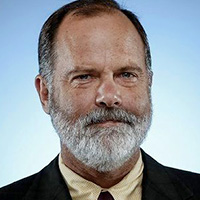CALIFORNIA RECORDED ITS FIRST COVID-19 death on March 4, 2020.
The following day, Santa Clara County recommended canceling major events. On March 9, a cruise ship carrying dozens of infected passengers belatedly docked in Oakland. Meanwhile, Italy, buckling under an uncontrolled outbreak, announced a nationwide quarantine.
At UCLA, top officials monitored those events with growing concern. Finals week was in mid-March, and Chancellor Gene Block initially hoped to keep the campus open during the exams. As the data poured in, that grew untenable.
“It became evident that for every day we waited, we put the community at risk,” said Michael Beck, administrative vice chancellor.
On March 10, Block ordered in-class instruction halted. UCLA’s bustling campus suddenly fell quiet. As students vacated Westwood, within two weeks on-campus housing went from serving nearly 13,400 students to about 700.
“Things happened very quickly,” the chancellor said, looking back on those events months later.
The wrenching changes at UCLA were felt in all walks of life. The campus, after all, is something of a small city, with nearly 45,000 students and 42,000 staff and faculty. Additionally, with $1.4 billion in annual research funding, projects across campus have broad implications for society. But could UCLA maintain safety while carrying out its core mission of education, research and service?
The answer, it turns out, is yes. After years of evaluating the implications of remote education, UCLA was abruptly compelled to embrace it wholesale. With barely a moment’s notice, classes moved overnight to remote learning, thanks to a monumental effort to support the transition. The campus procured Zoom licenses, ramped up IT capacity and lent students hardware such as laptops and mobile internet hotspots. The accumulated lessons of this period include significant insights that may help expand UCLA’s educational offerings in the future and may also provide new opportunities for adult education and alumni engagement.
Bracing for the worst
In the years before COVID-19, the idea of remote education was sometimes greeted skeptically. The coronavirus dramatically altered the equation, and Block braced for the worst. “I thought there might be an uptick in faculty retirements,” he said. There was not.
Still, stresses were immediate. Traditional lecture courses, built around professorial presentations to note-taking students, moved online without much effort, but more interactive courses — theater and music classes and science labs — were more difficult to conduct on digital platforms such as Zoom. Nevertheless, teachers adjusted.
By the summer, UCLA had built up a formidable library of content in the form of lectures, webinars, chats and other communications. Much of what had once transpired in the classroom now found a home online, and professors experimented with new ways of connecting, such as breakout rooms on Zoom and online office hours.
Students, already familiar with digital communication, were often more nimble than faculty. But the pandemic also exposed the disparate resources of UCLA students, one-third of whom will become first-generation college graduates.
For some, bringing a camera into crowded houses was difficult. Not all students have sturdy internet connections, and many were in crowded homes, where it was difficult to find privacy and space. Block, a first-generation college graduate himself, recalls a stark contrast during a spring course he taught: One student signed in from a well-appointed kitchen, while another was connected from a car, piggybacking on Wi-Fi while during a work break.
Professors initially insisted that students turn on their cameras so that the Zoom room would feel more like a class- room, but they learned to ease off. Similarly, courses that were still held at their original times proved difficult for those in other time zones, so many were recorded.
Despite some setbacks, advantages also emerged from the online experience. Every professor knows that in a class of more than 100 students, a dozen or so — often seated up front — will dominate discus- sions, while those who are less inclined to participate gravitate to the back rows. In the remote classroom, all faces are lined up in Zoom boxes, which means shyer students may feel more comfortable about taking part in an online discussion.
“Classrooms have dynamics,” Block said. “Some faculty are reporting that those dynamics change with remote education.”
Many startup frustrations gradually eased. “Students are resilient,” said Monroe Gorden ’94, vice chancellor for student affairs. Moreover, the administration learned. “Technology and equipment are now seen as basic needs for students,” Gorden said. In fact, they’re as essential as books. So UCLA is helping those who might otherwise find Internet access out of reach.
Changing the equation
UCLA is limited by space. It has the largest student body in the University of California system, and yet it has the second-smallest acreage. Classroom space is at a premium, limiting the number of students who can enroll in popular courses, which sometimes affects how quickly a student can complete major requirements to graduate.
Remote education, however, changes the equation. “The only way to do more on our 419 acres is by using technology,” Block said.
Imagine, he says, if UCLA students took one out of every four of their classes remotely. Larger numbers of students could join Zoom courses, some from home in the U.S. and others from locations around the world. The physical classrooms, meanwhile, could be repurposed for courses that require in-person sessions, allowing more students to participate in those as well.
Creating new space would, in turn, allow UCLA to address a fundamental constraint on its mission. Today, UCLA is one of the nation’s most selective universities, which means it is unable to accommodate thousands of qualified applicants who could thrive as Bruins if there were room.
As demonstrated over the past year, technology can offer ways to expand opportunities and help UCLA fulfill its broader social mission, without diminishing the experience. That would represent a powerful validation of the university’s COVID-19 experience.
From Westwood to Wales
There are some 500,000 UCLA alumni scattered around the world and in every profession. For most, the chance to reconnect with UCLA’s educational offerings may have appeal, but it is often impractical. Most live too far from Westwood and manage busy schedules that wouldn’t accommodate a return to college.
Now, however, UCLA is offering almost all of its educational and alumni programs through online platforms, which are as accessible from Westwood as they are from Wales. That shift, says Julie Sina, Alumni Affairs associate vice chancellor, has “given us the incredible opportunity to strengthen our alumni community.” In 2020, the UCLA Alumni Association presented 955 events, which included webinars and Zoom events as well as job search and networking forums. One event last May has been viewed more than 20,000 times by alumni in 70 different countries.
Going forward, more academic programs could be available to alumni who are contemplating changes in jobs or careers. This is where Block envisions a “lifetime warranty” that would be part of a UCLA education.
A UCLA alumnus who works as a law- yer might, years later, decide that her real calling is to be a writer, but she worries that it might be too late to make a change.
What if, by enrolling in a series of courses on Zoom, she could get the education she needed to land a job working for a media company? Or what about the alumnus who is wrestling with complicated family matters? Or those looking for insights into the worlds of politics or investments? UCLA offers courses with some of the world’s most brilliant people, but until now, connecting with their teaching meant coming to campus. What if that’s no longer required?
“It gives us an opportunity to rethink the value proposition of being an alumnus,” Block said. “It’s not just coming back for a football game or a tailgate.” The bottom line, he notes, is that “you have to meet people where they are.”
The loss of personal connection
Jan Reiff is a professor of history who teaches a well-regarded course on the 1960s. She also serves as a special assistant to Chancellor Block and Executive Vice Chancellor and Provost Emily A. Carter for online teaching and learning. As a result, she is better acquainted than most with the tensions that have existed around the online learning debate over the years. She’s heard the concerns and complaints of faculty who worry about the loss of personal connection with students. She’s heard students worry about the threat to a residential college experience. And she’s seen other institutions experiment and struggle with the same issues.
When UCLA quickly moved to online classes last March, Reiff says the initial reactions reminded her of those stuffed animals stuck on car windows, grimacing while gamely hanging on. And yet, all concerned persevered. It was a whirlwind of new experience, sometimes overwhelm- ing, but guided by a mutual determination to address the coronavirus while at the same time maintaining UCLA’s commitment to top-quality education.
As life has somewhat settled down, Reiff has seen the campus adjust and adapt. One consequence is that the old reservations are now tempered and informed by actual experience.
“The battle over whether online is evil and face-to-face is good has changed,” she said. In its place has arisen a recognition that a blend of personal and online education may create “a much more flexible environment that can benefit both.”
For example, online courses may allow calculus students to find the level at which they are challenged but not overwhelmed. Interns scattered around the world could join an online seminar about the vagaries of living abroad. Gaming software could be adopted for classes on dance or movie production or ensemble performance.
All of this would enhance education, not diminish or demean it.
Moreover, these new configurations might allow some students to occasionally join from home. That would free up space and resources at UCLA to expand other areas of teaching and research. As part of a blended model, technology then becomes a way of exploring behavior, Reiff said, rather than “a platform that forces behavior.”
In that light, UCLA’s experience with technology during this crisis is not pushing leadership to upend the fundamental relationship between teachers and students, nor is technology a vehicle for diluting the experience of going to college — living with other young people and immersing in a life that’s grounded in learning. Instead, this experience suggests there are new ways to expand the educational environment, address questions of inequality, connect more firmly and lastingly with alumni, and perhaps do more good in the world.
To Block, those are powerful inducements to do more — carefully, to be sure
— with appreciation for the potential to make UCLA an even greater contributor to education and culture. “The learning,” he said, “has been profound.”

























